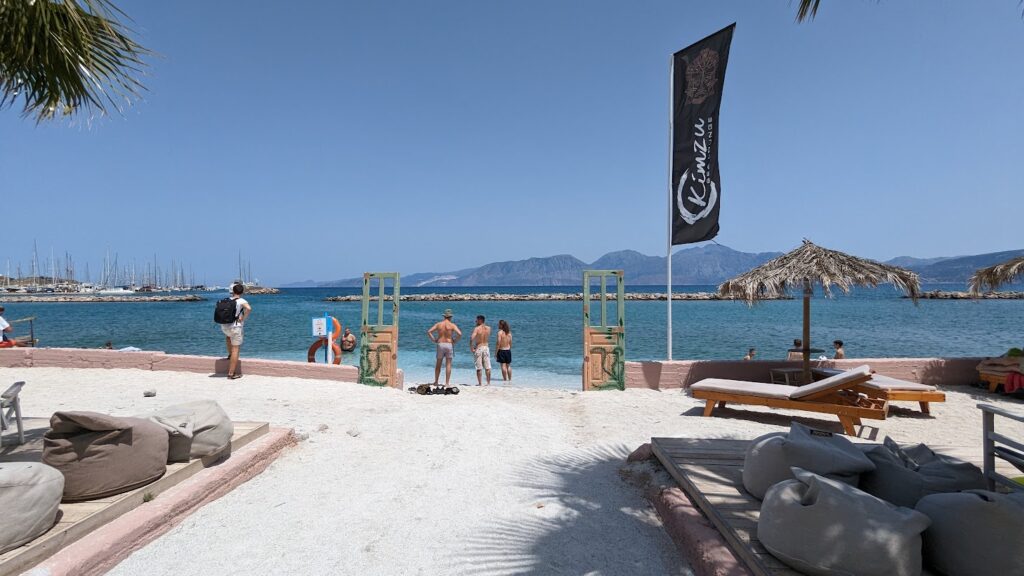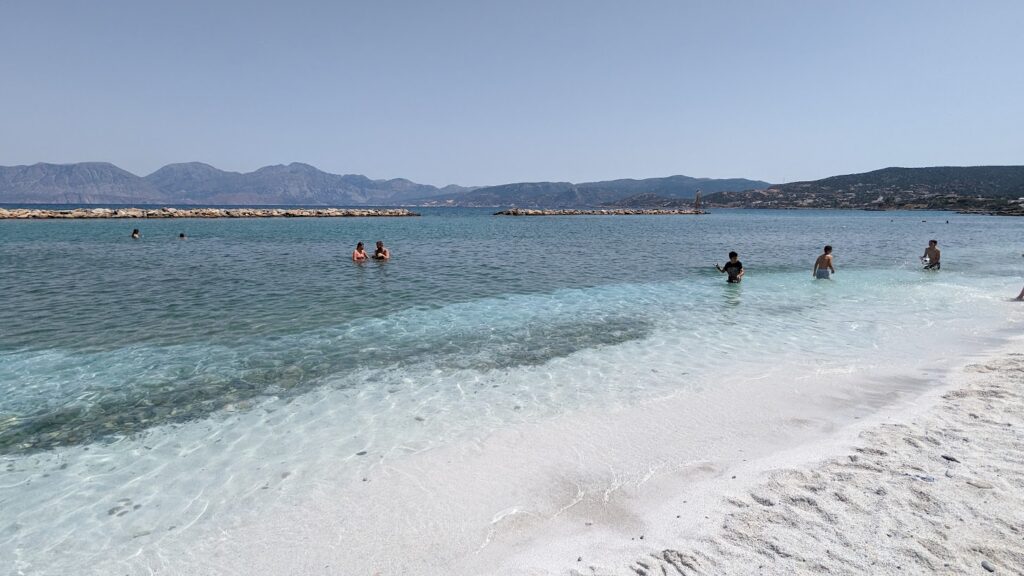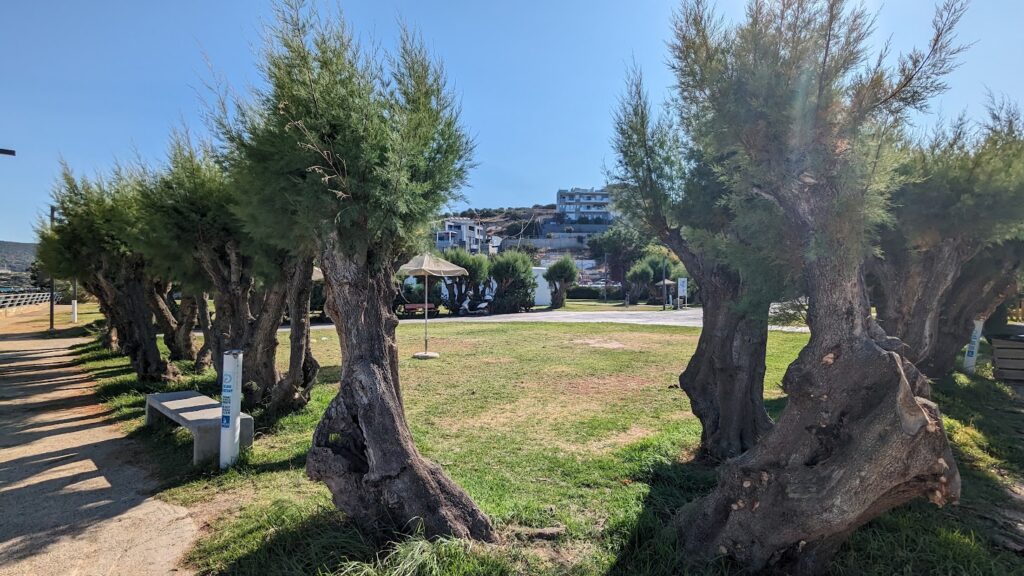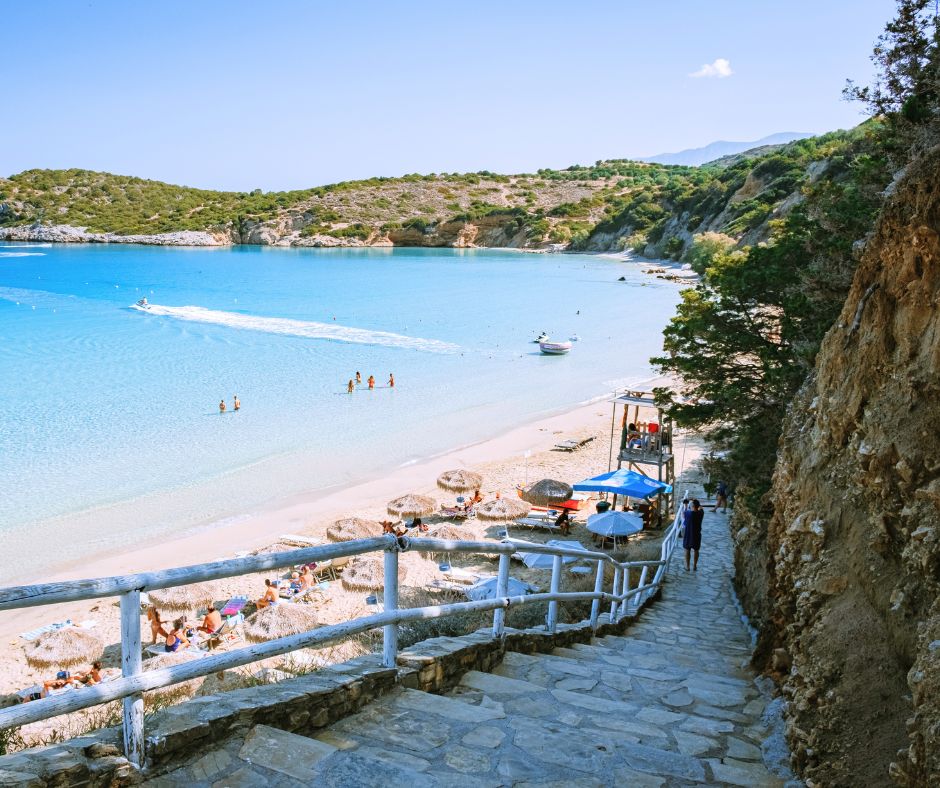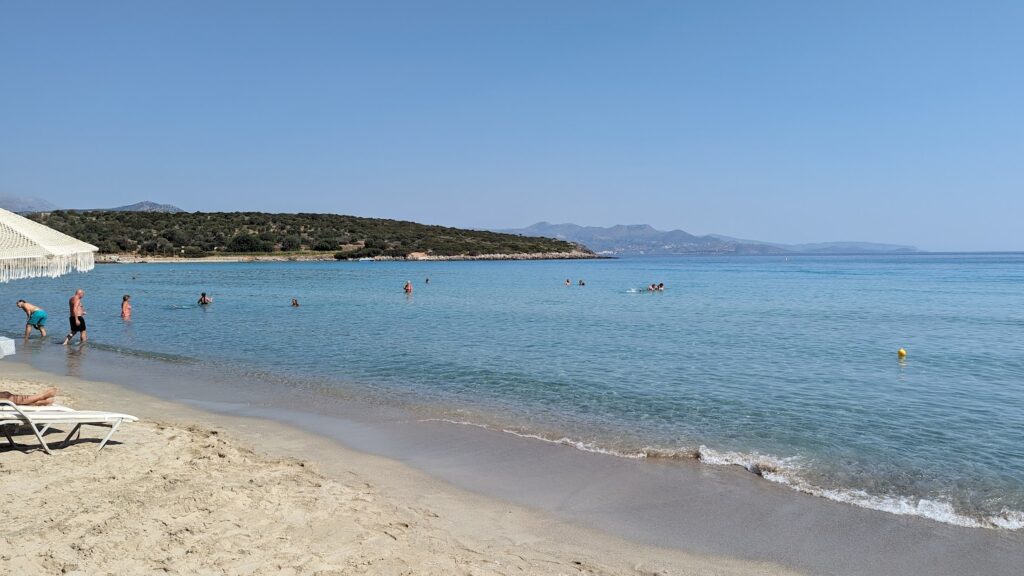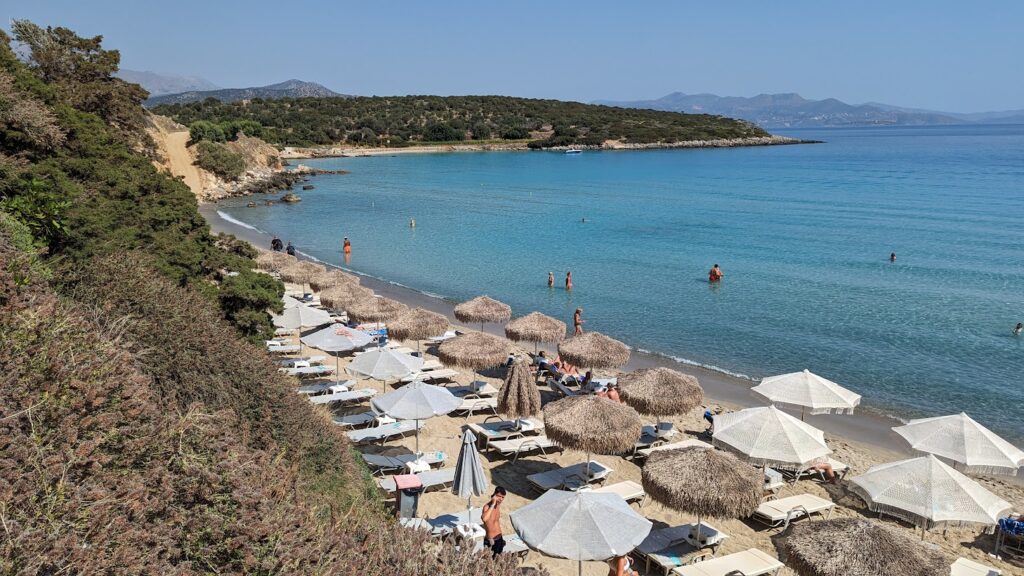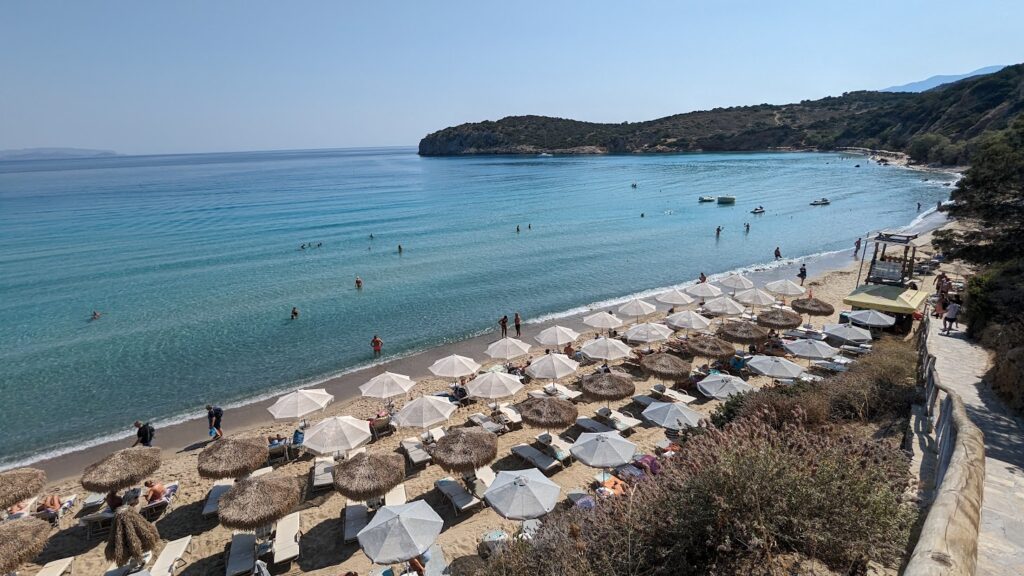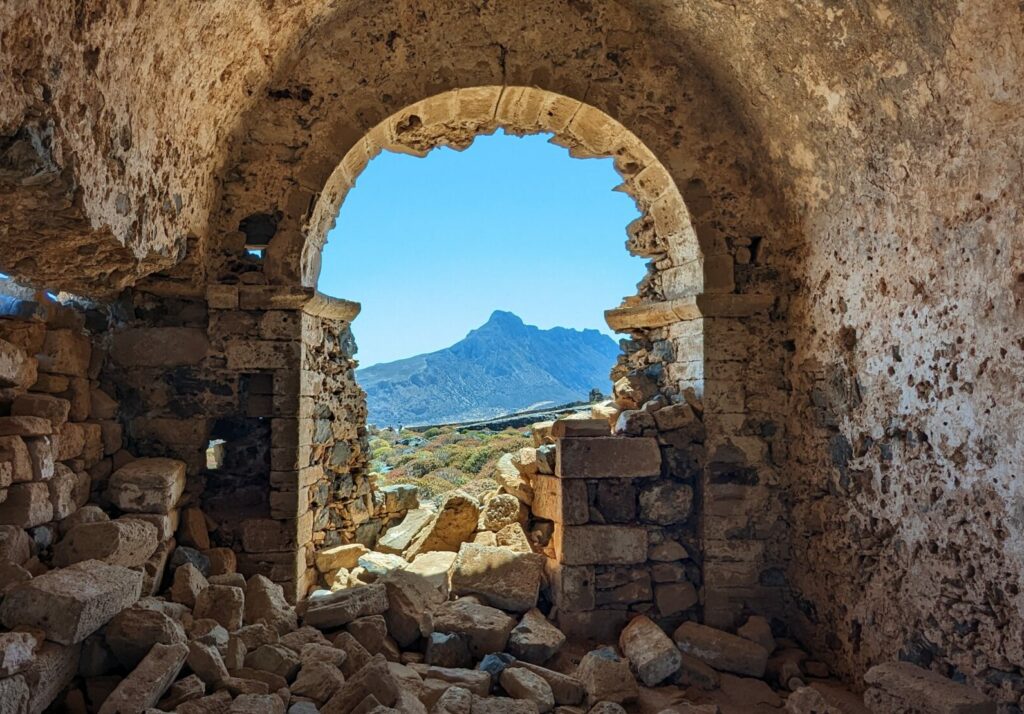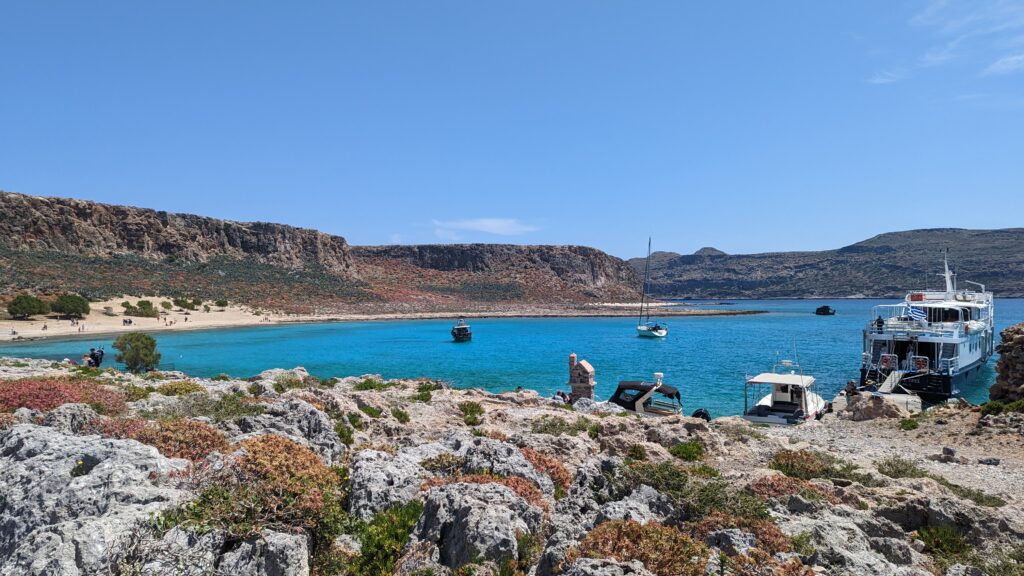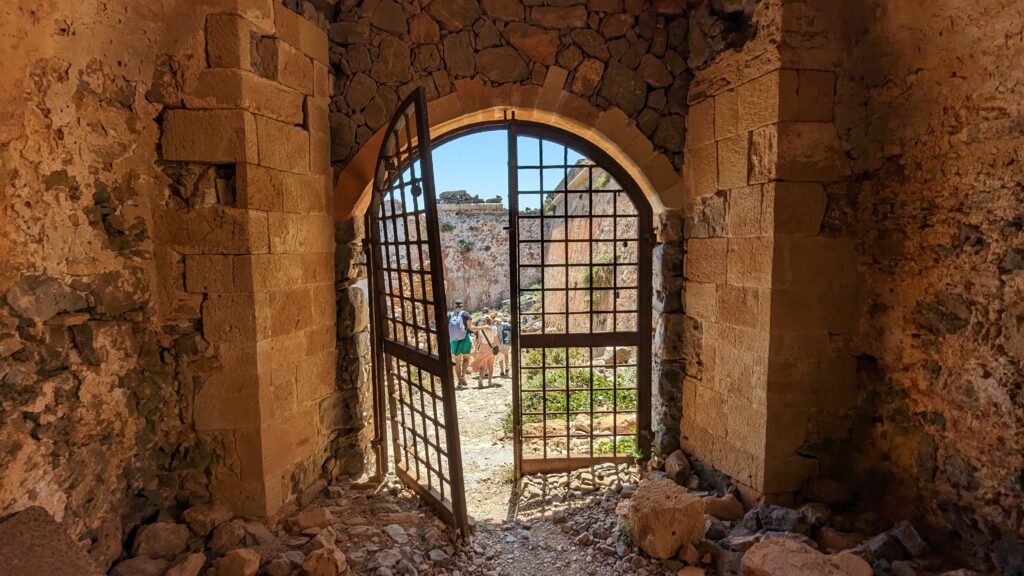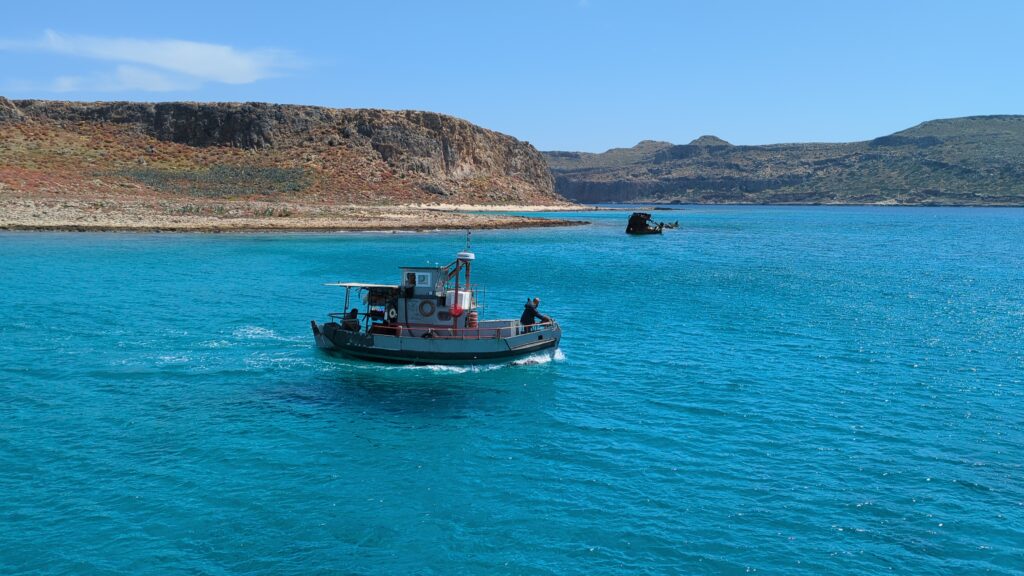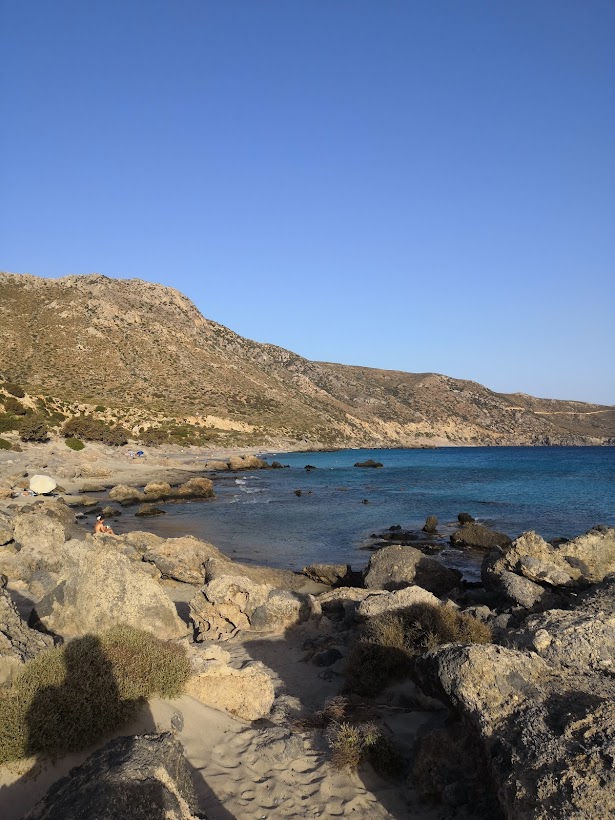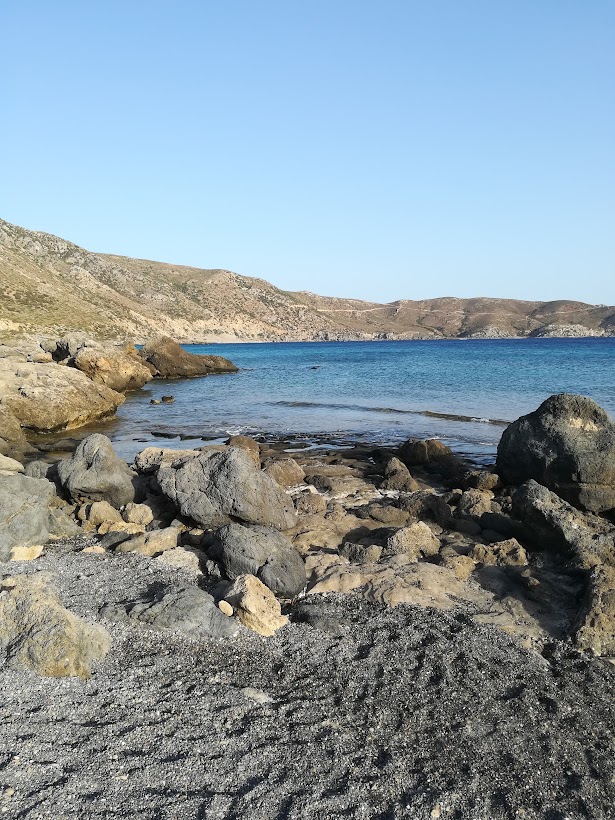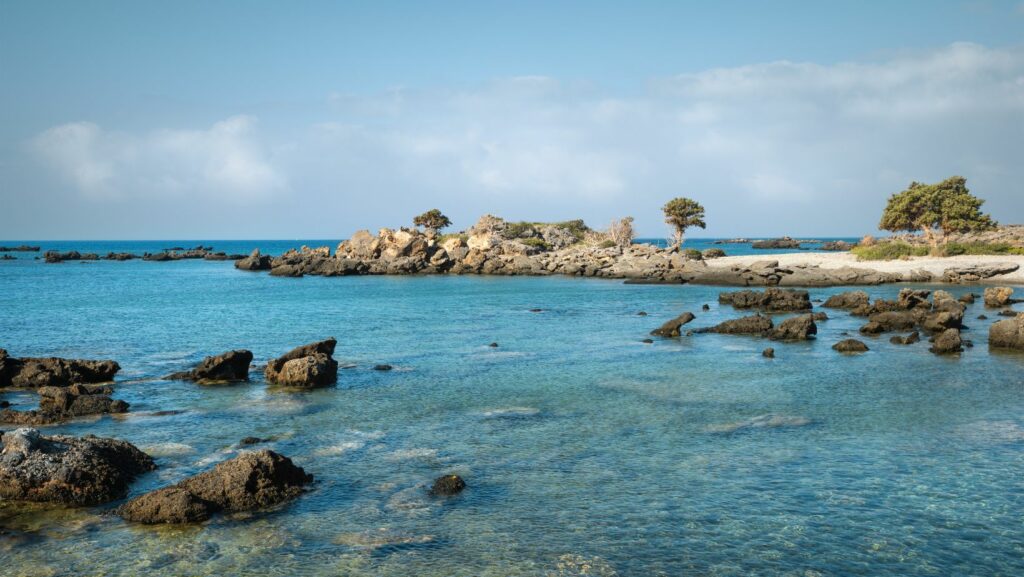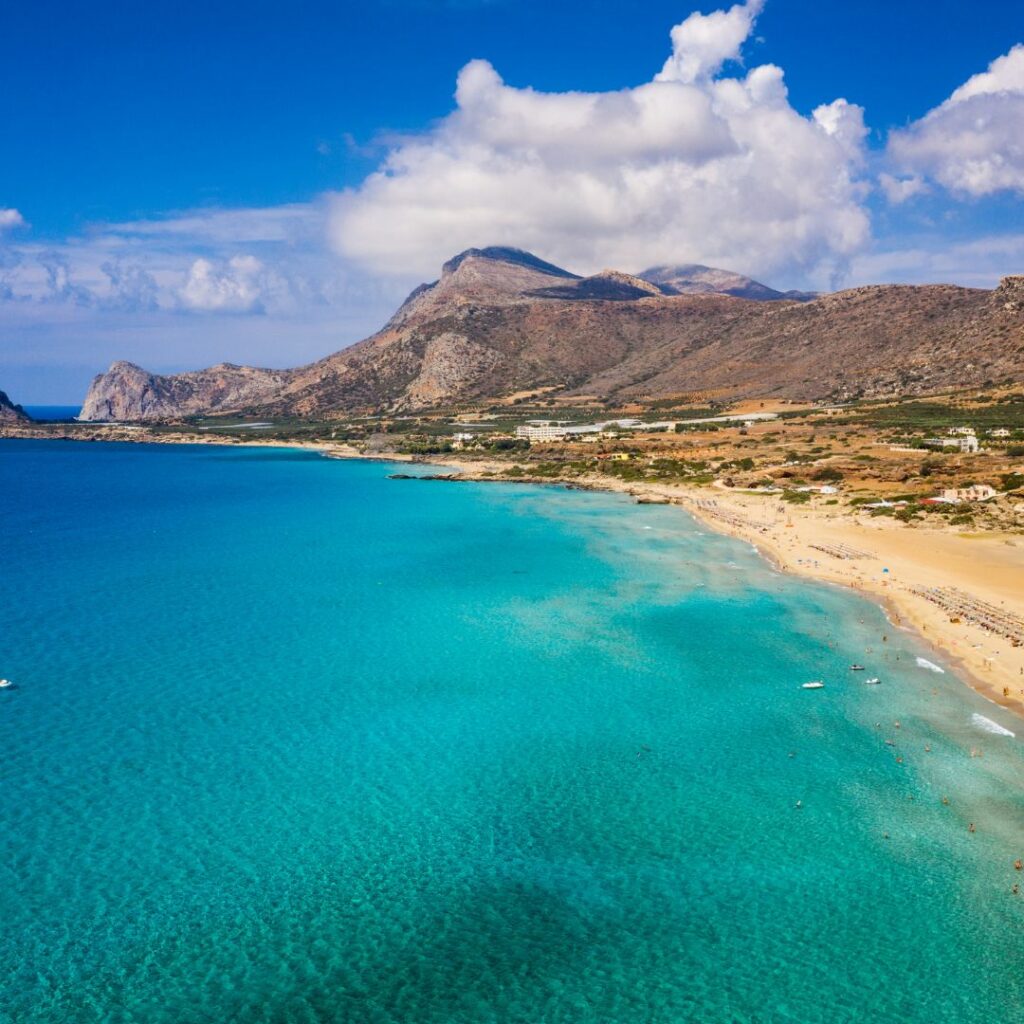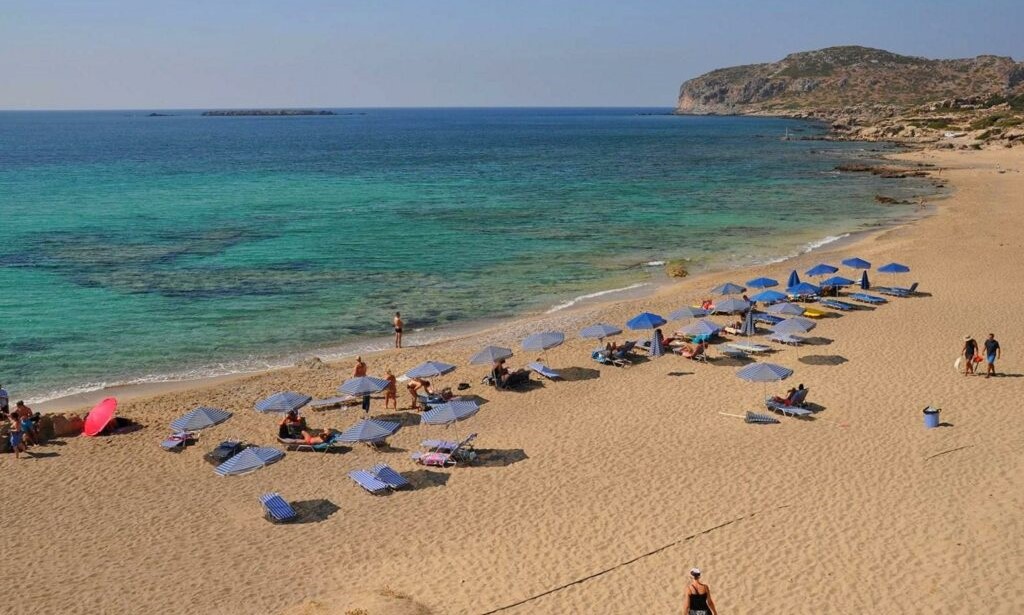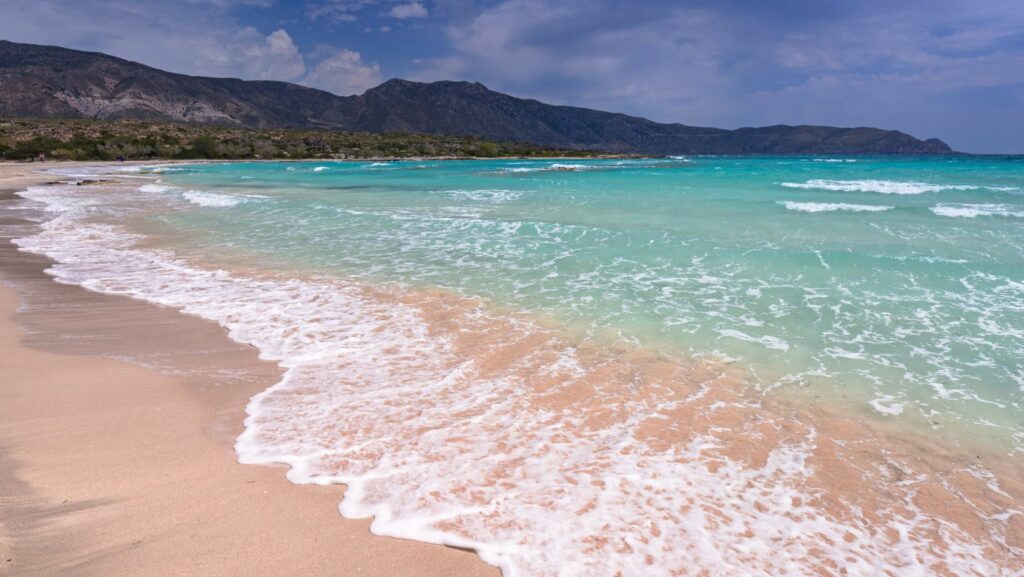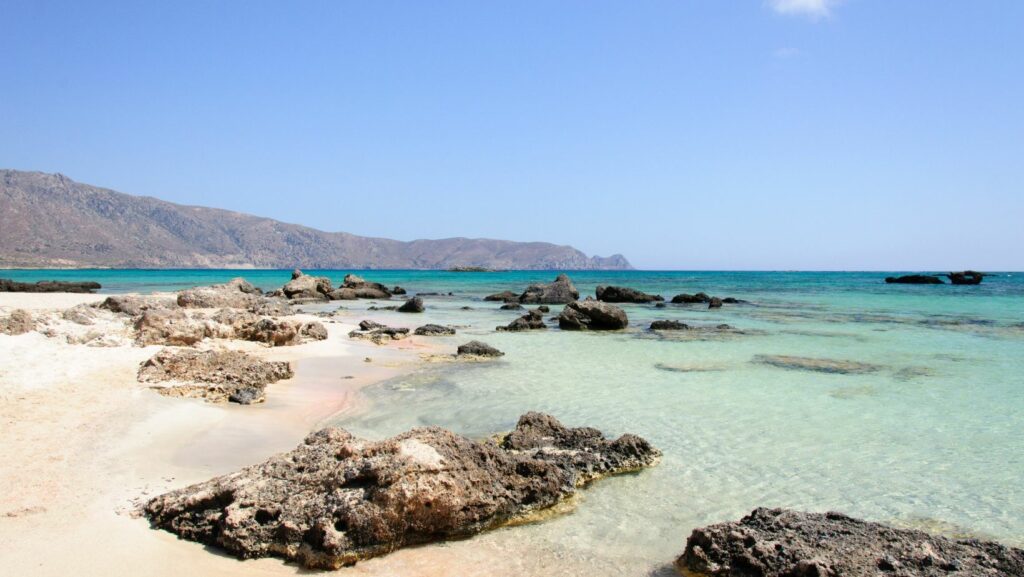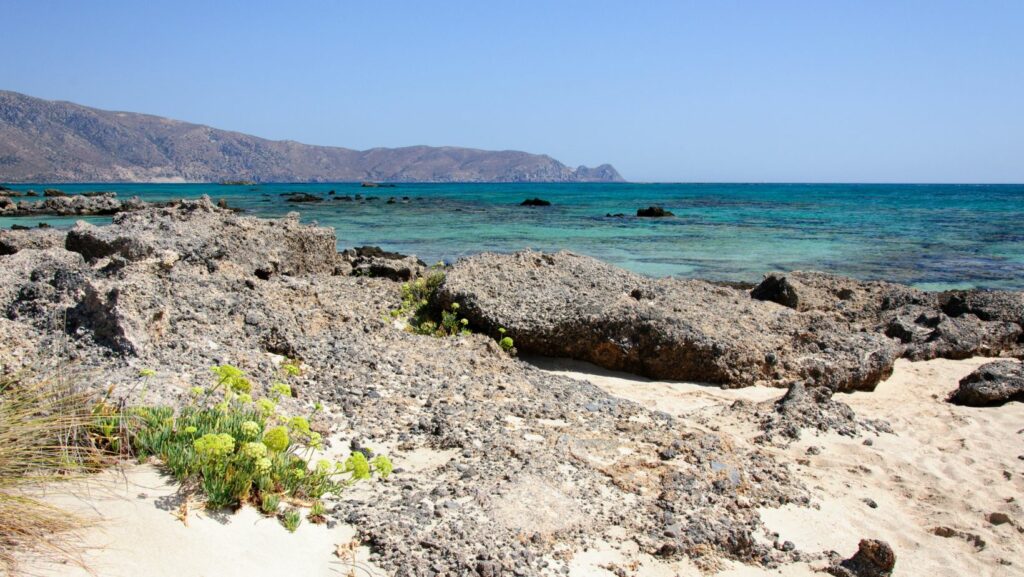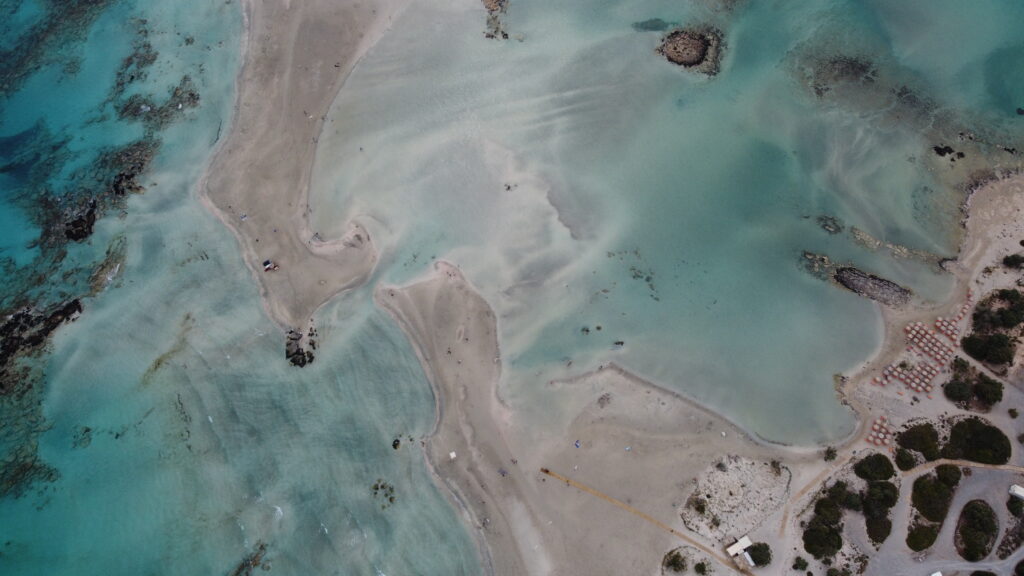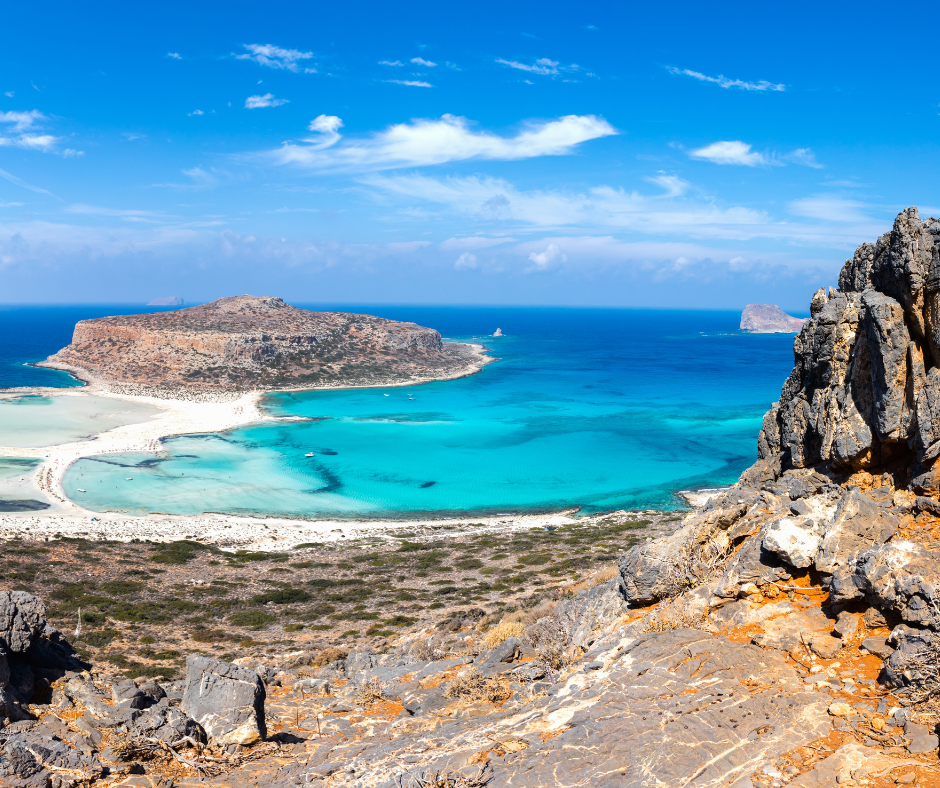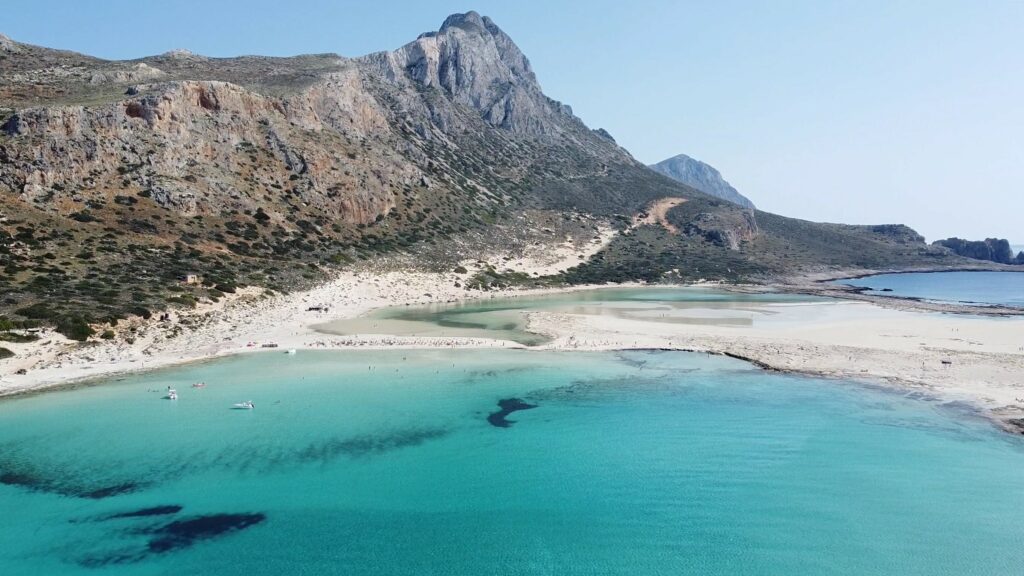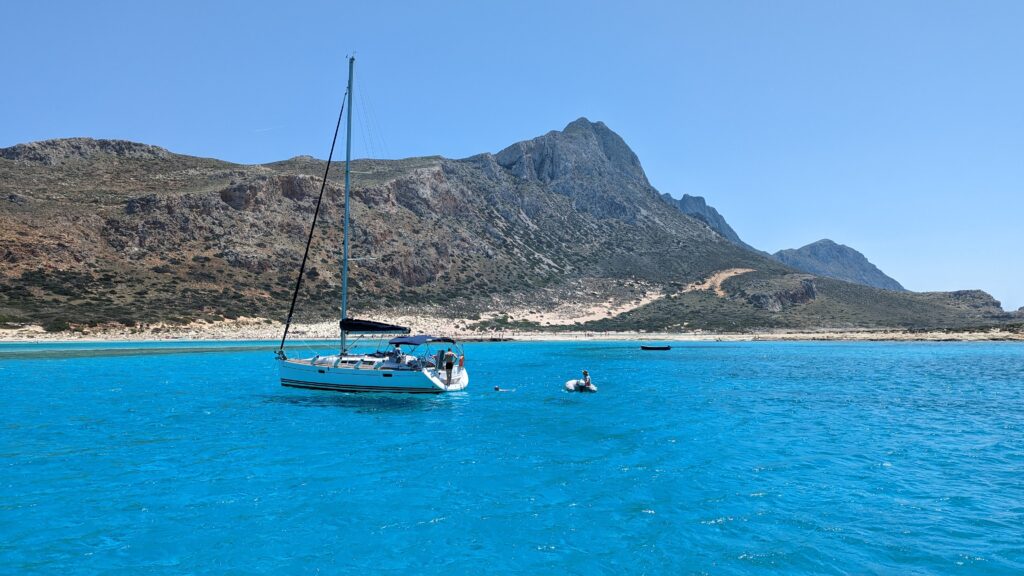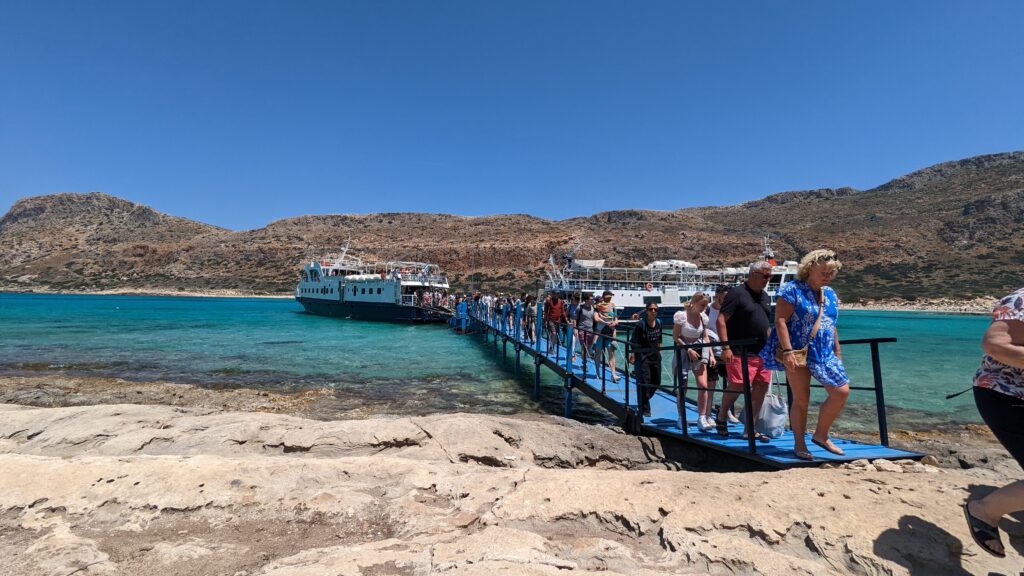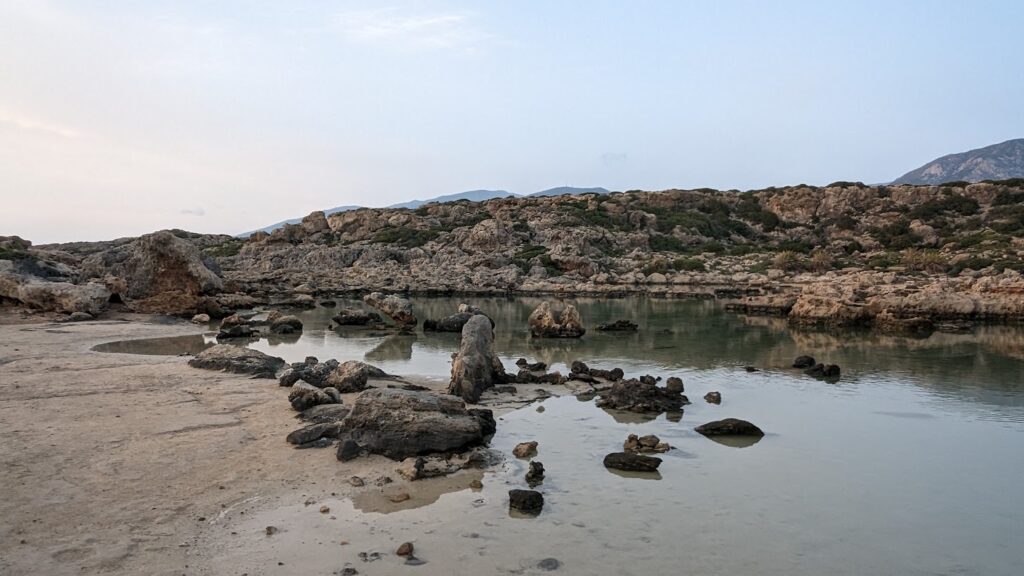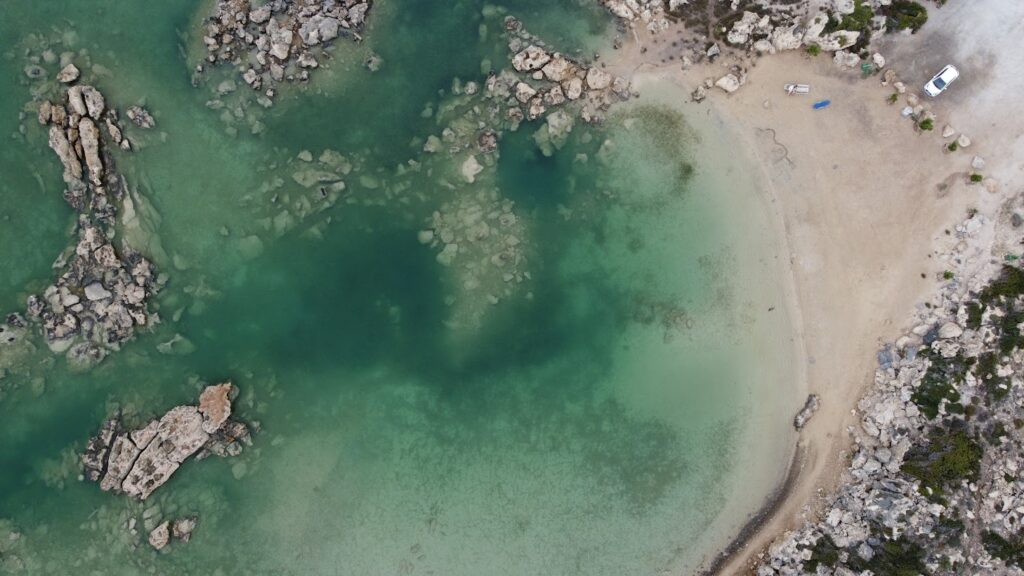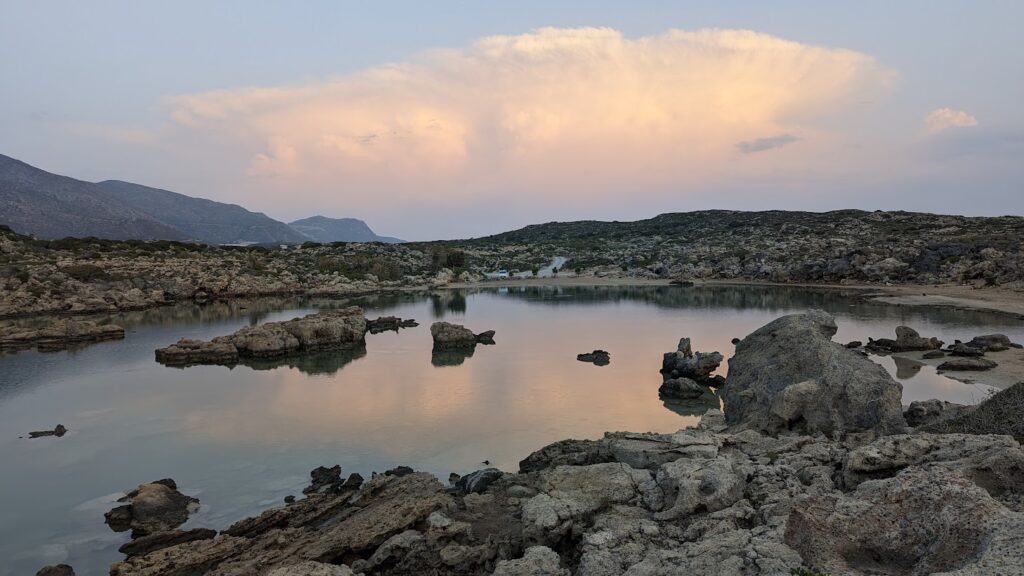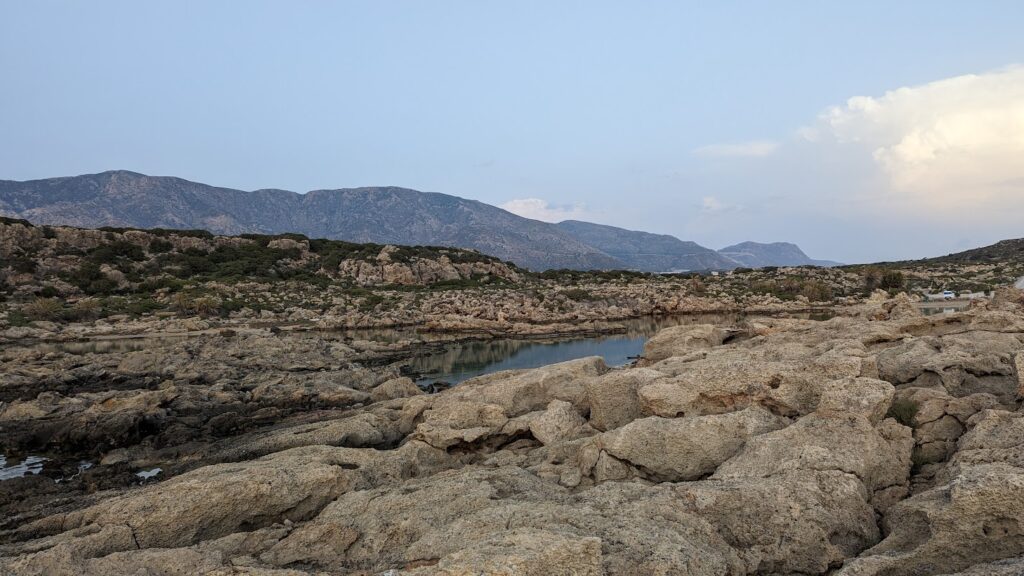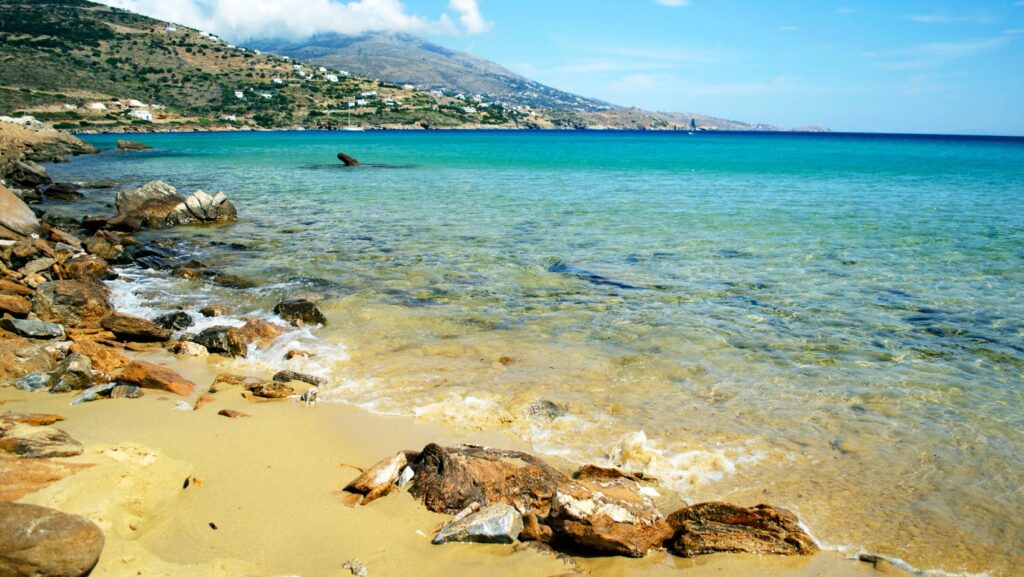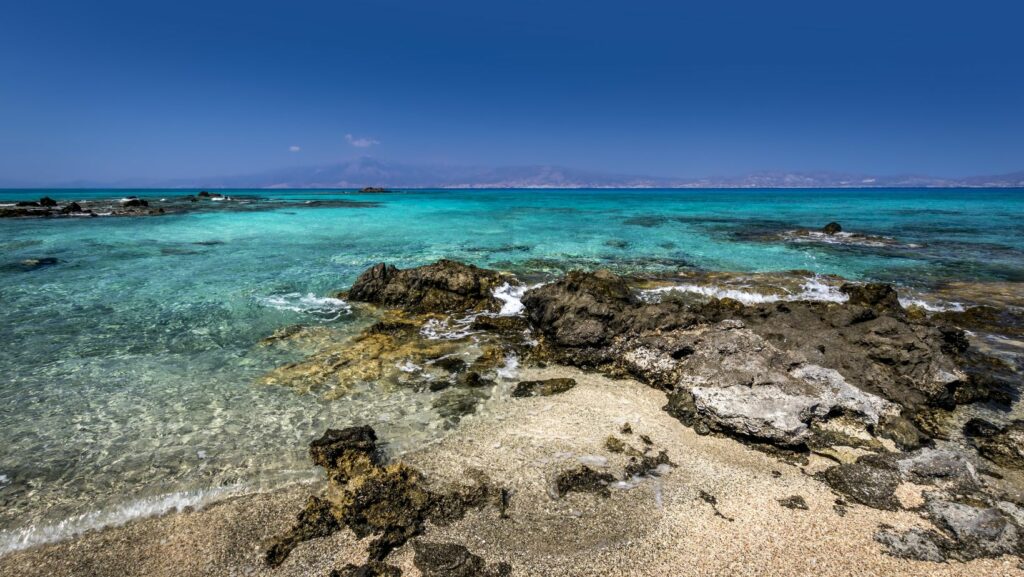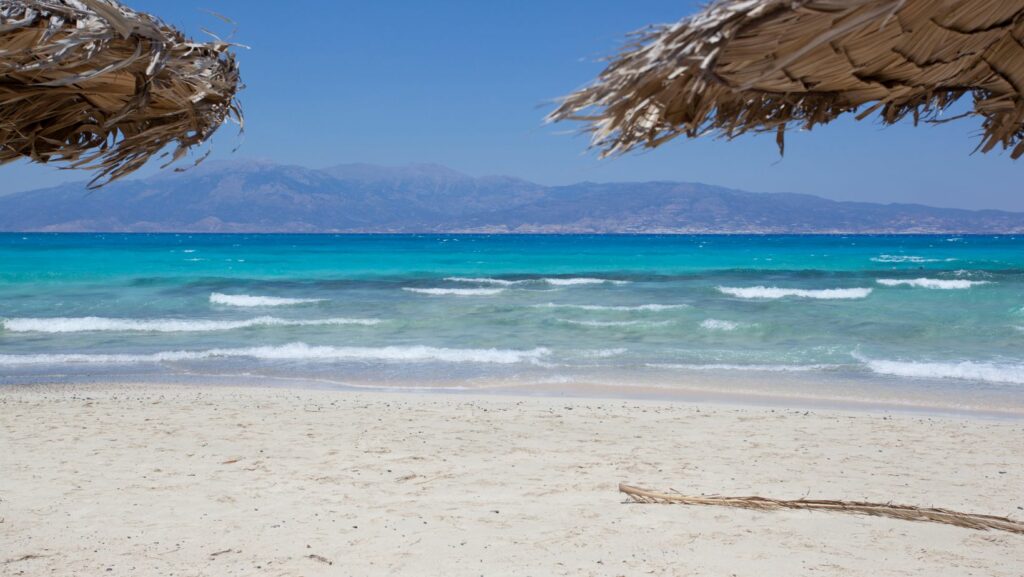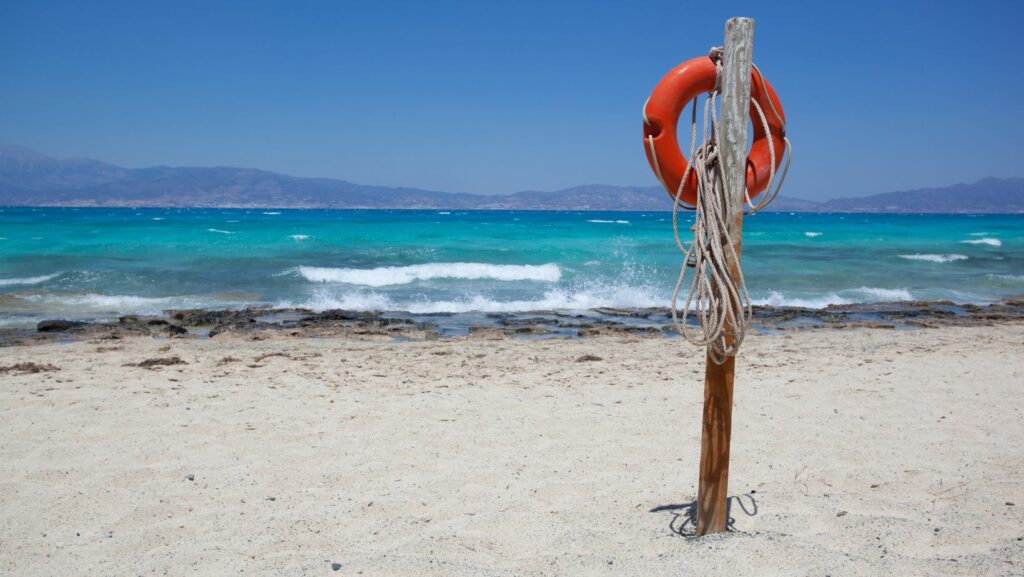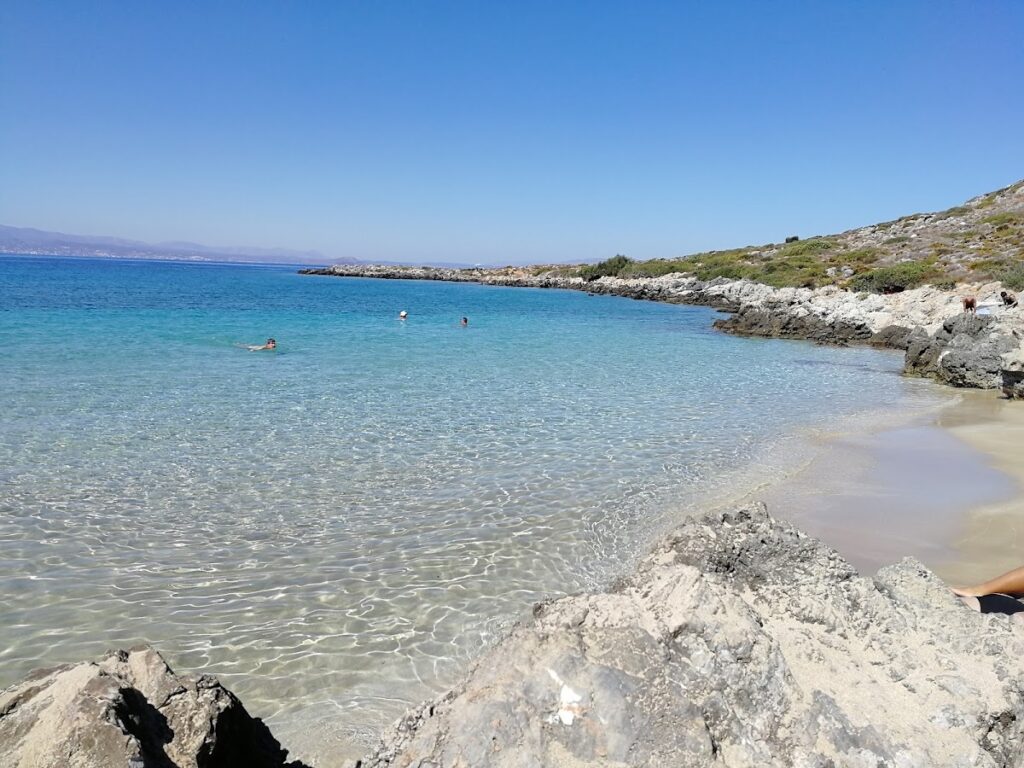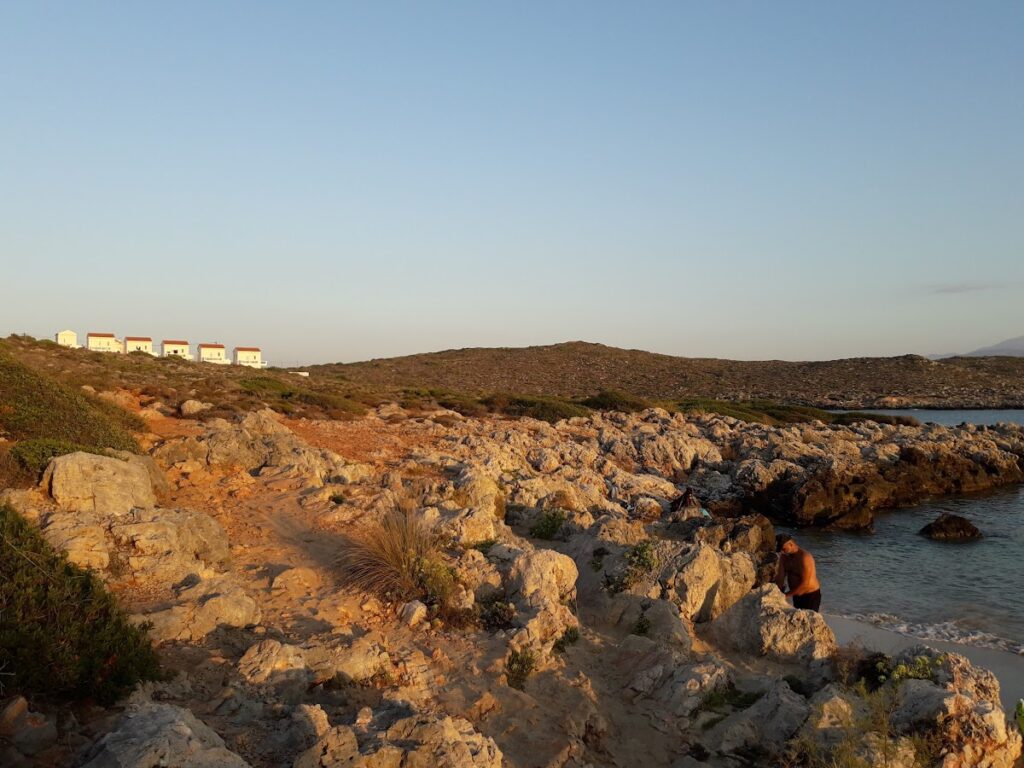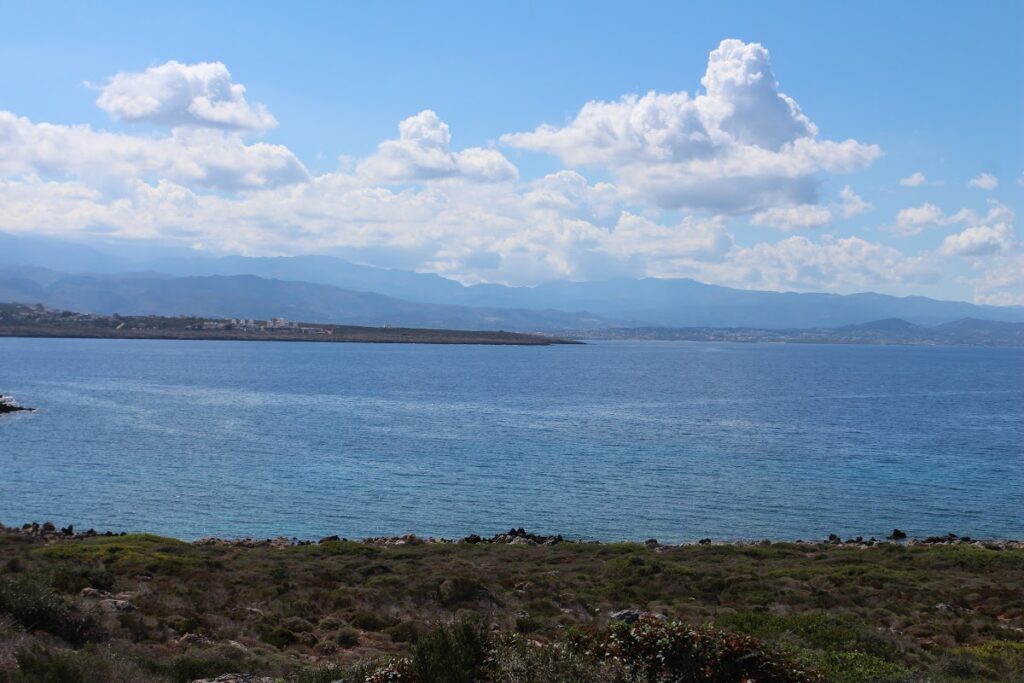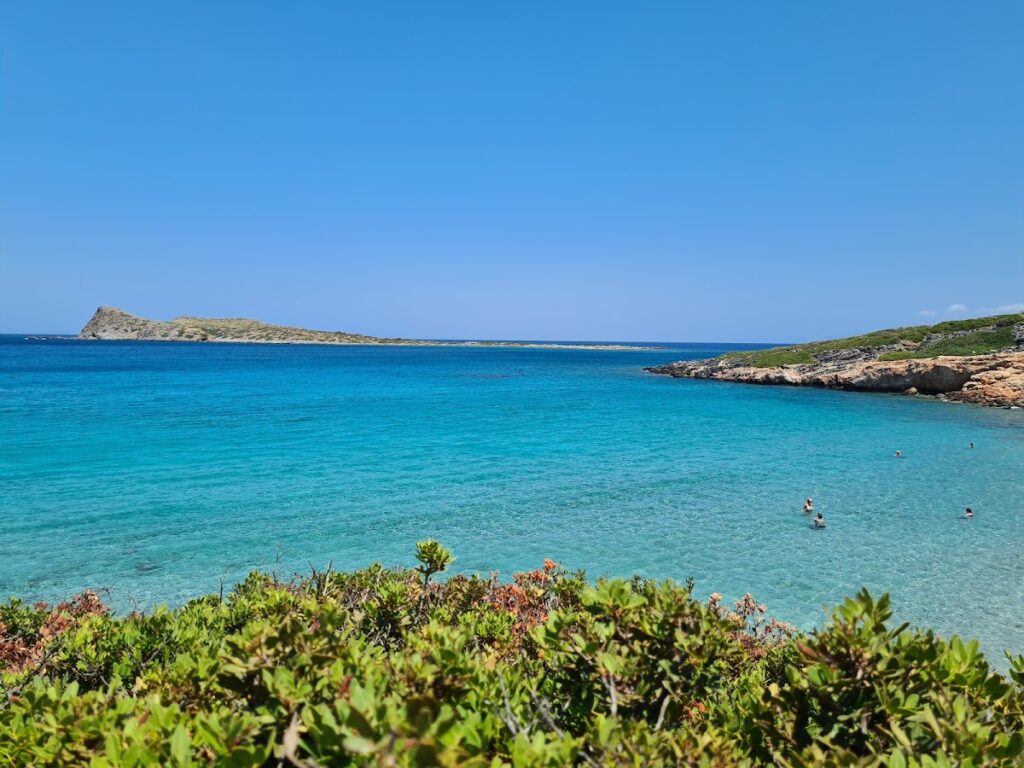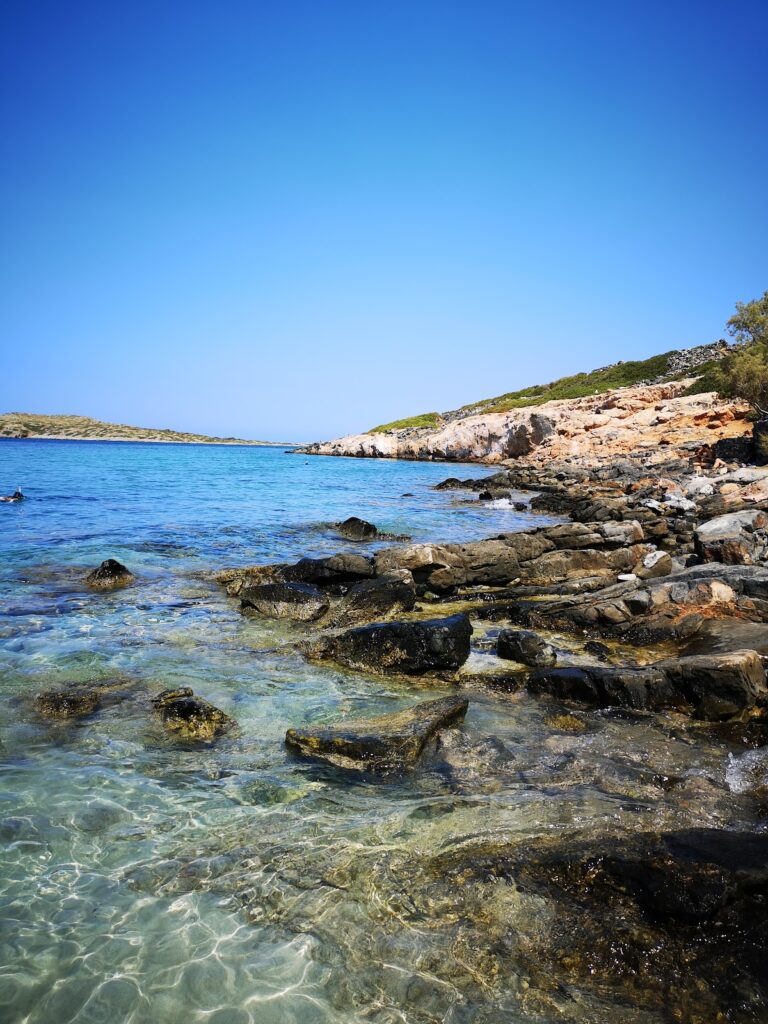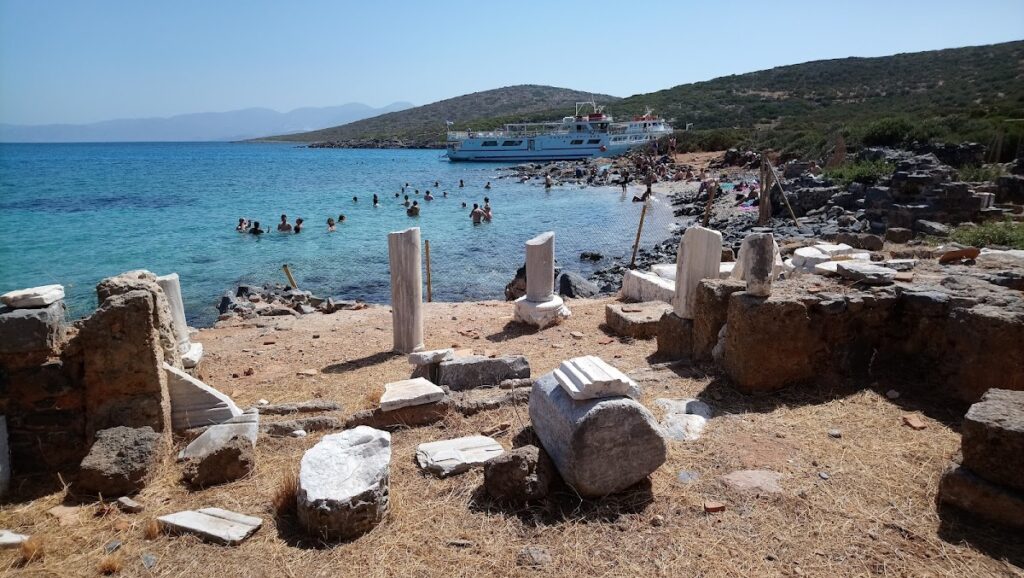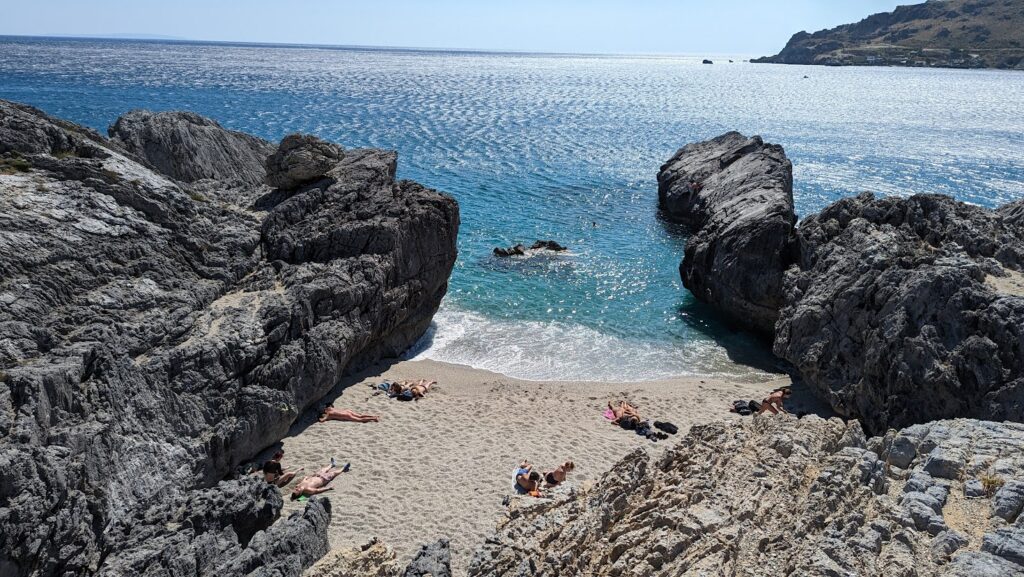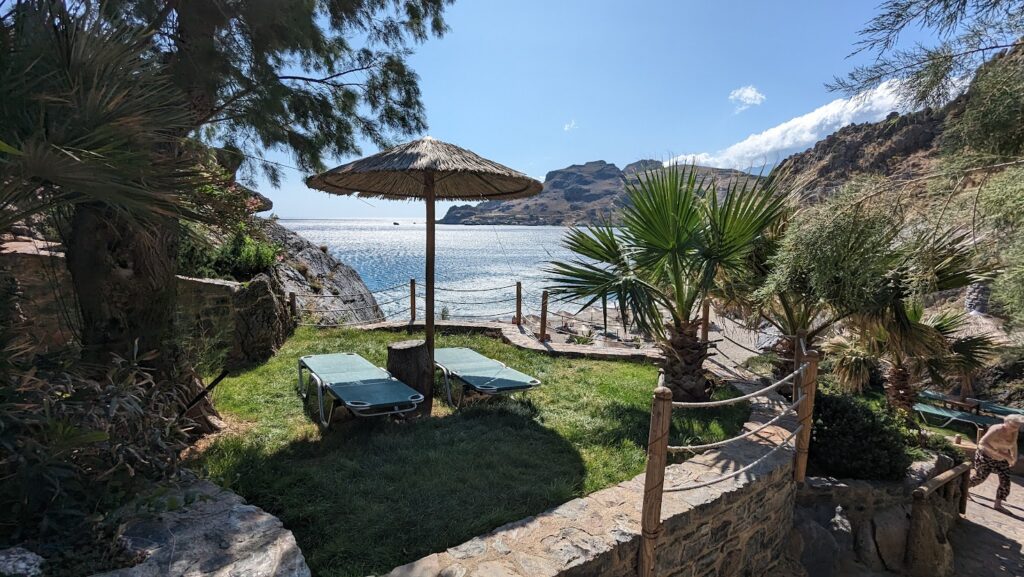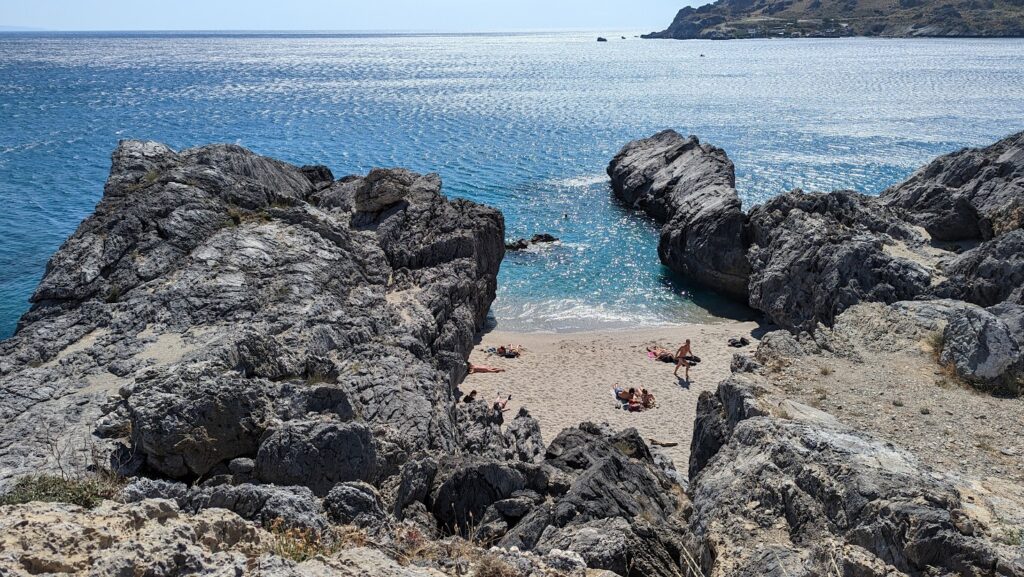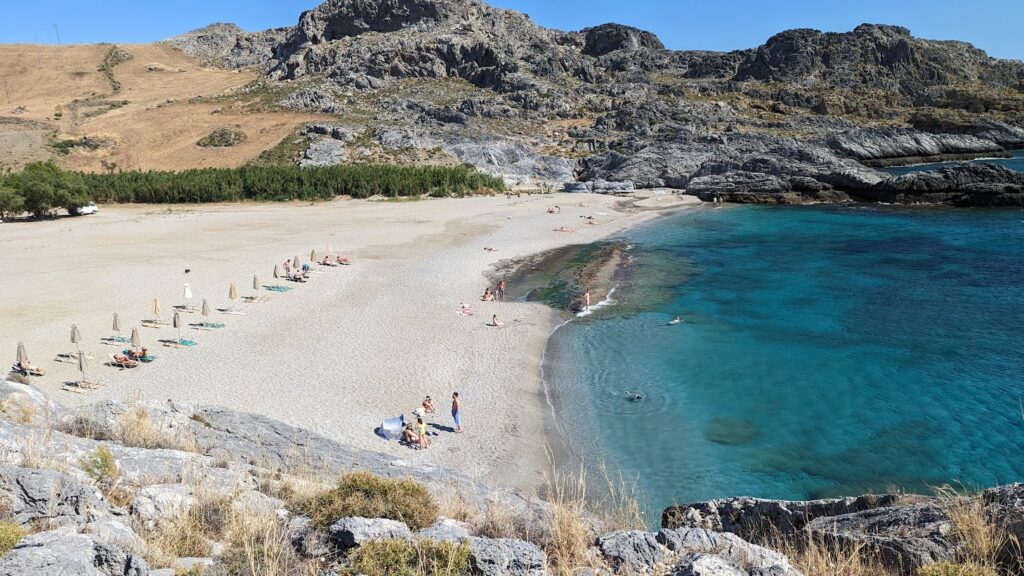Beaches with White Sand on Crete Island
Find a beach with White Sand near you
Discover the ethereal beauty of white sand beaches, a rare spectacle of nature. Our website is proud to present over 10 such unique destinations that are sure to leave you spellbound. Among them is the pristine Elafonisi Beach in Crete, a paradise on earth renowned for its pink and white sands against turquoise waters. Porto Katsiki in Lefkada offers breathtaking cliffside views of the Ionian Sea, coupled with its remarkable white sands.
The secluded Aspri Ammos beach in Othoni, with its unspoiled white sandy stretch, offers a tranquil sanctuary away from the hustle and bustle. For those seeking adventure, the windsurfing conditions on Prasonisi’s white sandy isthmus are exceptional.
Every one of these white sand beaches offers a unique sensory experience, be it the warmth of the sun, the sound of waves, the softness of sand underfoot, or the tranquillizing effect of a picturesque sunset. Each listing on our site provides detailed information on water quality, local amenities, and accessibility, ensuring an unforgettable and hassle-free beach vacation.
- Kimzou Sea Lounge Beach
- Fine Pebbles, White Sand
- Normal
- Blue, Deep blue
The charming Kimzu Sea Lounge isn’t just a fantastic bar, but also hosts an enchanting beach with shimmering white pebbles and sand, lapped by crystal-clear waters. The beach is located just 1 km away from Lake Voulismeni in Agios Nikolaos.
The beach offers full amenities, including an ample supply of sunbeds and umbrellas. Unique to this locale, visitors get to recline on lush, cool grass rather than hot sand, a delightful departure from typical beach experiences.
Despite its small size, the beach doesn’t usually feel crowded, offering ample space for all visitors. The water is shallow and inviting, making it particularly popular with families with young children. Strategically placed anti-wave blocks, about 120 meters off the coast, ensure the beach remains free of large waves, adding to its serene atmosphere.
Adjacent to the bar, a park provides additional recreation options, featuring a large children’s playground and a basketball court. It’s an idyllic spot for spending an entire day, from sipping on a rich Greek coffee in the morning, enjoying a delicious lunch and dinner, to toasting the day away with craft cocktails in the evening. The Kimzu Sea Lounge truly offers a comprehensive beach-bar experience.
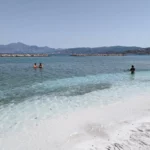
- Voulisma beach
- White Sand
- Shallow
- Turquoise
Voulisma Beach, one of Crete’s most celebrated coastal destinations, is a favoured stop for those journeying to this gorgeous island. Nestled in a shielded cove south of Agios Nikolaos and north of Ierapetra, Voulisma’s accessibility from Heraklion makes it a convenient beach spot.
Distinguished by its clear, shallow turquoise waters, smooth sand intermingled with pebbles, and its well-appointed amenities, Voulisma Beach has been recognized with the prestigious Blue Flag award. Even though the beach may attract crowds during peak times, its exceptional beauty certainly warrants a visit.
Voulisma Beach can be found on Crete’s northeastern coast, near Istro or Istron village. It’s the most notable of several beaches dotted around the trio of bays at Istro, all part of the larger Mirabello Gulf. The larger town of Agios Nikolaos is a 13 km coastal drive north, while Ierapetra lies 22 km south.
In the vicinity of Voulisma Beach, the intriguing archaeological site of Gournia is a standout attraction. Located near Pachia Ammos village and around 10 km east of Voulisma Beach, it is one of the most well-excavated Minoan towns on Crete. Once a bustling ancient settlement, it was ravaged by an earthquake and subsequently abandoned.
Around 11 km southeast of Voulisma Beach, on a steep slope, sits the captivating Panagia Faneromeni Monastery. Worth visiting for its stunning church built into a cave and the awe-inspiring sea views, this monastery is a well-known destination in Crete. Every year on the 15th of August, it becomes a pilgrimage site, drawing visitors from across the island.

- Gramvousa Islet
- Rocks in places, White Sand
- Normal
- Turquoise
The island of Imeri Gramvousa is located 20km northwest of Kissamos, opposite the imposing Cape of Gramvousa and 2 miles northwest of the famous lagoon of Balos.
Its historical significance is captured by the majestic Venetian fortress that remains standing 137m above the beach. This fortress is not just a relic of the past but also an icon of pirate legends, which suggests a buried treasure somewhere on the island. An old shipwreck, long deserted near the beach, has become an integral element of Gramvousa’s unique panorama.
Two sizable bays on the island’s southern flank cradle the iconic shipwreck between them. The western bay, situated below the castle, is a popular destination for hundreds of daily visitors who arrive via excursion boats from Kissamos, a journey that takes an hour. These boats make a stop at Gramvousa before heading onward to the stunning Balos Beach.
Visitors have the chance to explore the castle and shipwreck, as well as indulge in a refreshing swim in the crystal-clear waters of the western cove, adjacent to the Holy Apostles Church. The beach, known for its mesmerising turquoise hue, features a mix of white sand and occasional rocky spots. Tamarisk trees near the beach provide a natural shade, while the area’s seabed is a snorkeler’s delight. Excursion boats provide food and water from onboard bars. Due to the area’s protection under the Natura 2000 program, no additional facilities are available, and overnight stays are prohibited.
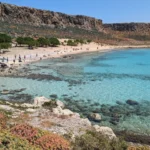
- Kedrodasos beach
- Rocks in places, White Sand
- Shallow
- Turquoise
Kedrodasos, named for its distinct juniper forest, is a stunning beach located 76km southwest of Chania and just 1km east of the famous Elafonissi lagoon. This beach is dotted with enchanting juniper trees, often confused for cedars, that are beautifully tucked in between sandy dunes. Included species are the twisted Juniperus oxycedrus subsp. macrocarpa and Juniperus phoenicea. Visitors are encouraged to treat these delicate trees with kindness and care.
Covering an impressive area of around 11 hectares, the juniper forest offers a magnificent view. The beach is an ideal spot for swimming and is a favorite among naturists. It features a diverse landscape of white sand and occasional flat, smooth rocks. A lack of nearby amenities emphasizes the secluded allure of Kedrodasos, maintaining it as one of the last untouched havens in Europe. Visitors are encouraged to leave nothing behind, ensuring the beach stays clean and untouched.
Acting as a shield from the regular winds of neighboring Elafonissos, Kedrodasos offers a relatively serene sanctuary. The beach also serves as a stopover for the European E4 trail, with yellow and black markers indicating the way.
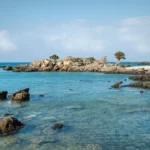
- Falassarna beach
- Rocks in places, White Sand
- Normal
- Turquoise
The stunning Falassarna beach is situated 59km to the west of Chania city and about 17km to the west of Kissamos, at the western end of the Gramvousa peninsula. The northern end of this beach features the remains of the ancient Greco-Roman city of Phalassarna. Widely acclaimed, Falassarna is home to some of the most celebrated beaches in Greece, having been awarded the best beach in Crete and recognized as one of the top 10 European beaches multiple times. The area spans a large expanse and is made up of five consecutive beaches, with the two central beaches being the most popular.
The whitish sand on Falassarna gives the water a tropical hue. Visitors may find themselves entranced by the beach and its turquoise waters, provided the west wind is not blowing (which is rare in west Crete). The main beach, Pachia Ammos, is a 1km long and 150m wide exotic beach. Despite being the most popular, due to its size, it never seems too crowded. There are a few snack bars, cafes, umbrellas, and services for water sports and beach volleyball courts.
To the north of the main beach is another 800m long beach that is divided into smaller beaches by a sand dune and some rocks. This beach is quieter than Pachia Ammos and offers no facilities. A small cove facing south near the archaeological site is also an option for those who prefer isolation, although it has a rocky seabed. A long sandy beach at Livadi, located to the south of Pachia Ammos, is great for snorkelling and is surrounded by a wetland area that attracts many birds during winter. South of this beach, near the small harbour of Limeniskos settlement, there is a small pebbly beach, which is ideal for those who prefer not to stay remote.
Falassarna is situated in a protected nature reserve, and the sunset considered the best in Crete, is a romantic sight to behold. However, one drawback is that the beach is typically wavy due to its westward orientation, although this is desirable for windsurfers. The area’s greenhouses are also rumoured to pollute the sea with fertilizers and waste, which is unfortunate if true. Visitors who lack transportation can take the bus from Chania or Kissamos.
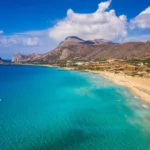
- Elafonissi beach
- White Sand
- Shallow
- Turquoise
Elafonissi beach, situated in the southwesternmost point of Crete, is found 76km west of Chania and 5km south of Chrysoskalitisa Monastery. The beach is actually an oblong peninsula that can be separated into two parts by water, giving the illusion of two islands. This area is strictly protected under Natura 2000 regulations due to its abundance of sand dunes, sea daffodils, and junipers. Moreover, this island serves as a sanctuary for several rare species of animals and plants, including the endangered loggerhead sea turtle. As such, visitors are prohibited from removing any plants, animals, shells, or sand from the area.
On both sides of the peninsula, visitors can enjoy exotic beaches that feature white sand and turquoise water, similar to the Caribbean. The sand has a pinkish hue, which is derived from millions of crushed shells. At the peninsula’s breaking point, the seawater is not deeper than 1m, which creates a shallow lagoon ideal for children. Visitors can easily cross the lagoon while carrying their belongings, as the water is quite shallow.
The eastern side of the beach, located in front of the lagoon, is well-equipped and crowded with visitors. Facilities include umbrellas, showers, lifeguards, snack bars, and changing rooms. Nearby, there is a large parking area, as well as a few rooms available for rent. Conversely, the beaches on either side of the peninsula are less populated and are considered the most beautiful due to their mesmerizing azure colours. For those seeking complete seclusion or wishing to go nude, there are some coves available for naturists near the west end of the peninsula.
How to Get to Elafonisi Beach from Chania
Elafonisi is a corner of paradise on the southwestern coast of Crete, included in the top 10 best beaches in the world. To relax on the white and pink sand and swim in the crystal clear sea, guests of Crete come here from all over the island in all possible ways: by car, public transport or as part of an excursion group.
From Chania to Elafonisi by car
It will take at least 1.5 hours to get from Chania to Elafonisi beach. Elafonisi is located 75 km from Chania city. The best option to travel around Crete is on your own, of course, in a rented car with a navigator. There are two ways to get to the beach by car:
-
- Along the west coast on the E65 with wonderful views. The road goes past Kissamos, along serpentines. This round is longer but less stressful.
- Through the mountains and past the Topoli Gorge along the road that cuts through the interior of Crete. First, you need to take the National Highway to Kissamos, then turn left from the E65 highway. This path is shorter but can take longer, as you will have to move along narrow mountain roads.
Both roads are paved and equally picturesque. It is difficult to drive past Elafonisi: all the signs that you will meet along the way lead to it.
From Chania to Elafonisi by bus
Chania is connected to Elafonisi by bus. The KTEL bus departs from the city bus station at 9:00 and returns at 16:00. One-way trip takes about 2 hours. The ticket price is approximately 11 euros. This is a more complicated way than by car.
Another option is to book a guided day trip from Chania to Elafonisi Island, with hotel transfers. In this case, you do not have to worry about the difficulties of the road.
How to get to Elafonisi from Rethymnon
From Rethymno to Elafonisi by car
From Rethymno to Elafonisi is about a 3.5-4 hour one-way drive. Rethymnon city is located 129 km from the famous Elafonisi beach. It is better to leave by car at 5-6 in the morning in order to be in Elafonisi as early as possible. After driving to Chania, you need to keep heading for Kissamos and turn inland or continue along the serpentines along the coast.
From Rethymno to Elafonisi by bus
There are no direct buses from Rethymnon to Elafonisi. But you can get from the Rethymnon bus station to Chania, spend the night in this city, and in the morning take a bus from Chania to Elafonisi.
You have also the option to book a guided day trip from Rethymnon to Elafonisi Island. The trip starts with a hotel pick-up. After arriving at Elafonisi, you will have 4 hours of relaxing on the beach and swimming in crystal-clear waters. Afterwards, you will have time to enjoy lunch at a local tavern before heading back to Rethymnon.
How to get to Elafonisi from Heraklion
The road to Elafonisi from Heraklion will be long. This city is much further from the beach than Chania and Rethymno (210 km), so the best option is to plan a two-day trip.
From Heraklion to Elafonisi by car
Drive along the National Road towards the west to Chania. Then the path follows the same pattern as if you were leaving from Chania.
From Heraklion to Elafonisi by bus
Take a bus from Heraklion bus station to Chania. Here you can get out and go for a walk around the picturesque city, spend the night in Chania, and take a bus to Elafonisi in the morning.
And again you have the option to book a guided trip from Heraklion to Elafonisi.
Other ways to reach Elafonisi Beach
Elafonisi can be reached by sea from Paleochora. Boats leave this village at approximately 10:00 and return at 16:00. Services are provided by both excursion companies and private traders who do not have a set schedule. Due to the fact that it takes as long to get to Paleochora as to Elafonisi, a sea trip will be relevant only for those who are nearby.
The infrastructure of Elafonisi Beach
The beach belongs to the specially protected natural sites of the island, so in this place, you will not find water activities; catering on Elafonisi is represented mainly by kiosks and small bars where you can buy snacks and drinks. There are umbrellas and sun loungers at a fixed price, but it is more convenient (if you are by car) to take sun umbrellas with you, in which case you can choose the part of the beach that you like the most, and not huddle on the most crowded equipped area with other vacationers. Sun protection for adults and children is a must as there is no natural shade.
The beaches of Elefonisi are ideal for families with small children: a gentle descent into the water allows you not to worry about the safety of the kids. In addition, you can swim here even in a storm: due to the shallow depth, there are no big waves on Elefonisi.
Parking, located near the beaches, on the island part of Crete, is free. During the summer months, Elefonisi is wildly popular with tourists, so in order to stroll along the coast in relative seclusion, it is advisable to arrive early in the morning.

- Balos Beach and Lagoon
- White Sand
- Shallow
- Turquoise
The famous Balos beach is a well-known lagoon found approximately 56km northwest of Chania and 17km northwest of Kissamos, situated between Cape Gramvousa and Cape Tigani below the range of Platiskinos. It is highly photographed and a popular subject for tourist guides in Greece. It was also visited by Prince Charles and Princess Diana on their private yacht many years ago.
Balos is renowned for its striking turquoise waters, picturesque natural scenery, and stunning exotic beauty. During summer, thousands of visitors arrive mostly by ferry from Kissamos port. However, it can be overcrowded, especially in July and August, so it is advisable to visit in the morning before the boats arrive, to enjoy a few hours of isolation in this breathtaking paradise.
The lagoon’s white-pink sandy beaches feature vivid blue and turquoise waters, which are very shallow and warm, ideal for young children. The sand has a lovely pinkish hue in many areas due to millions of crushed shells. The water beyond the lagoon’s rocky boundaries is deeper and colder, perfect for snorkelling. The wider area, including the lagoon, has rare flora and fauna species and is protected under the Natura 2000 program. Eleonora falcons, shags, and cormorants nest in the caves of the area, while the monk seal and the loggerhead sea turtle (Caretta caretta), which are protected species, also find refuge there.
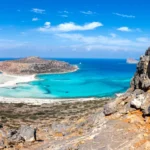
- Aspri Limni beach
- Rocks in places, White Sand
- Shallow
- Turquoise
Aspri Limni, translating to ‘White Lake,’ is one of Crete’s most remarkable and yet little-known beaches. Located a mere 500 meters west of Chrysoskalitissa Monastery and 70 kilometres southwest of Chania city, it’s a hidden gem just waiting to be discovered. While many flock to the nearby popular lagoon of Elafonissi, Aspri Limni remains largely unexplored, its beauty preserved in its pristine condition.
The beach, adorned with fine white sand and occasional rocks, is enveloped by jagged cliffs, creating the illusion of a tiny pale lake within the sea. Undisturbed by commercial tourism, Aspri Limni retains its pure and untouched charm, although it lacks natural shade.
To reach Aspri Limni, take a right turn in Chrysoskalitissa village and follow the signs leading to the small Phoenix Theophrasti (Cretan Date Palm) habitat located around the lake. If unsure, any local will be able to guide you to this hidden beach.
Protected under Natura 2000 due to its significance as the westernmost habitat of the endangered Phoenix Theophrasti, Aspri Limni holds environmental importance. This palm species is also found in other groves in Crete such as Vai, Preveli, Agios Nikitas, Souda, and in smaller colonies in South Turkey. Among these, Vai hosts the most extensive palm grove.

- Golden Beach Belegrina
- Sand, White Sand
- Normal, Shallow
- Blue, Turquoise
Crete is home to numerous stunning beaches, and the Golden Beach on Chrissi Island is considered one of the finest in all of Europe. However, a significant update has recently been implemented by the local government: they have suspended all boat access to the island.
Here’s what this implies:
- Disembarking from all types of vessels is now prohibited, meaning no boats are allowed to dock at Chrissi Island.
- While visitors are permitted to swim from their boat to the beach, they are prohibited from venturing into the island’s interior. This is an effort to protect the habitat of the island’s sea cedars.
- Essentially, boats will drop you off 10-20 metres from the shore, from where you’ll need to swim to reach this paradisiacal beach.
- The island no longer features sun umbrellas or other amenities.
These changes have been put into effect to preserve the land and marine environments of Chrissi Island.
Typically, throngs of visitors would arrive daily by boat from Ierapetra to enjoy the famous Belerinina or Golden Beach on Chrissi Island. The stunning tableau of vivid blue waters, white sands tinged pink from countless crushed shells, and junipers with expansive roots holding the sand in place is an irresistible allure for anyone.
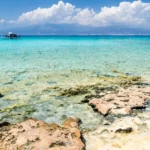
- Maherida Beach
- White Sand
- Shallow
- Turquoise
Macherida, a small beach, is situated 14km northeast of Chania and 1km west of Chorafakia village, in close proximity to Tersanas. Its name is derived from the Greek word “machairi” meaning “knife,” inspired by the knife-like appearance of a rocky cape at its northern end. Another theory suggests it was named after the Gladiolis italics flower, known as “macherida” in Greek.
The bay, facing southwest, is typically calm. At the heart of the bay lies a beautiful beach with white sand and turquoise water, enclosed by sharp rocks. The water clarity here is exceptional due to the sea currents that frequently change direction, sweeping away any rubbish. While the beach isn’t developed, there has been some residential construction in the vicinity in recent years. Macherida beach, with its seclusion, is a popular spot for nudists and is one of the preferred beaches for the gay community in Chania.
The surrounding coastline serves as a unique habitat for various wild species. Close to the main road, amidst the rocks, is the Macherida pond that resembles a crater with saltwater springs. This provides a sanctuary for water snakes, turtles, and seagulls. The city bus route to Stavros passes through Tersanas and runs close to Macherida beach.

- Kolokytha beach
- Sand, White Sand
- Shallow
- Turquoise
The small island of Kolokytha is situated directly across the Spinalonga Peninsula, a mere 12km north of Agios Nikolaos and nearby Elounda. The island faces the stunning Agios Loukas beach, also known as Kolokytha beach.
Kolokytha Beach, a secluded sandy haven, is nestled amidst protective cliffs. Known for its tranquil and crystal-clear waters, it’s perfect for a range of activities like swimming, sunbathing, and various water sports. This beach is a hotspot for recreation, offering opportunities for camping, snorkelling, and hiking. Its remote charm is enhanced by unspoiled, clear waters and a natural setting free from the clutter of umbrellas and sunbeds.
To reach the beach, a picturesque route from Elounda town is necessary, which takes you eastwards along the coastal road past the old Elounda salt pans. This road traces a thin stretch of land towards the Spinalonga Peninsula, sometimes mistakenly referred to as Kolokytha. Along this route, you will encounter a small canal created by the French army in 1897 to connect the Elounda lagoon to Mirabelo Bay. Surrounded by windmills, a charming bridge and boats in the canal, the landscape is truly unique. The road then transitions into a dirt track where you must make a right turn after 200-300m. This track will lead you across the Spinalonga Peninsula, offering breathtaking views of its rocky shores and deserted farms.
After a brief 3-4 minute journey, you will arrive at the church of Saint Luke, where it’s recommended to park. From here, you can see Kolokytha island, home to thousands of nesting gulls. The north reveals the Byzantine chapel of Saint Fokas, built to honor Byzantine emperor Nicephorus Phocas who freed Crete from the Arabs in 961 AD.
Though hidden from view at the chapel, the beach is nearby. Follow one of the 2-3 foot trails downhill and you’ll soon discover one of Crete’s most beautiful beaches. This secluded cove, with white sand and crystal-clear calm waters, is nestled among ancient olive groves and wheat crops. Despite its popularity and potential crowding during peak times, an early morning or late afternoon visit will reassure you of the beach’s exceptional charm.
If solitude is what you seek, head southwards beyond the beach’s right edge. Here, you’ll find two quiet bays with sand, rocks, and several tamarisk trees, named Vagi after the Greek word for the Cretan date palm. While less striking than Kolokytha, they offer a haven for nudists and those seeking tranquillity. You can still see remnants of a small limestone quarry nearby. The broader area is dotted with abandoned farmlands and an old farmhouse close to the beaches.
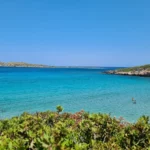
- Ammoudi beaches, Plakias
- White Sand
- Normal
- Turquoise
Located 32km south of Rethymno and 4km east of Plakias, you’ll find the beach complex of Ammoudi. Access is available via a paved road from the village of Lefkogia. This road leads you directly to the first beach, Ammoudi, recognizable by its distinctive green slippery rock. The beach has a slight organization, with available amenities such as umbrellas, nearby taverns and rooms, and even a scuba diving centre. Its thick white sand, rocky seabed, and bright green waters make it ideal for diving and snorkelling. There’s also the option to find shade and camp under the many tamarisk trees located next to the beach.
Heading west from Ammoudi, a dirt road begins that will take you towards Damnoni, passing by towering cliffs and impressive rocks. Just 200m west of Ammoudi, along this dirt road, you’ll discover a parking plateau that offers an unrestricted view of Damnoni. Here, you’ll see an enchanting miniature sandy beach, featuring turquoise waters and a unique rock in the sea. Known as Klisidi, this beach is an attractive choice when not crowded, though this is rare during peak season.
Adjacent to Klisidi, you’ll encounter the stunning nudist beach of Small Ammoudi or Ammoudaki. This small beach is popular among nudists for its turquoise waters and exceptional white coarse sand. It also has a small canteen offering umbrellas and sunbeds. On the beach’s west side, you can swim in a marine cave, where the sunlight turns the water a vibrant blue. You can easily walk on the sandy seabed. There’s also an underwater hole connecting Ammoudaki with Klisidi, allowing you to travel between the two beaches with just a dive. If you wish to reach the Ammoudi beaches on foot, simply walk east of Damnoni until you reach Ammoudaki.
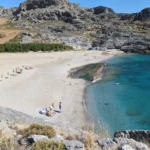
There are no results matching your search.
Reset
